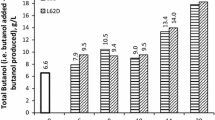Abstract
A soil isolate of Lactobacillus animalis was found to produce a bacteriocin-like inhibitory substance (BLIS) with a wide inhibitory spectrum against Gram-positive bacteria. The isolate exhibited high BLIS production in broth containing surfactants, such as Tween 20 and 80, but low BLIS production in the absence of surfactants. Culture temperature also had an effect on BLIS production. This is the first report to study the production and characteristics of L. animalis BLIS.

Similar content being viewed by others
Literature Cited
Contreras BG, De Vuyst L, Devreese B, Busanyova K, Raymaeckers J, Bosman F, et al. (1997) Isolation, purification, and amino acid sequence of lactobin A, one of the two bacteriocins produced by Lactobacillus amylovorus LMG P-13139. Appl Environ Microbiol 63:13–20
Garver KI, Muriana PM (1994) Purification and partial amino acid sequence of curvaticin FS47, a heat-stable bacteriocin produced by Lactobacillus curvatus FS47. Appl Environ Microbiol 60:2191–2195
Harvey SM, Sturgeon J, Dassey DE (2002) Botulism due to Clostridium baratii type F toxin. J Clin Microbiol 40:2260–2262
Hernández D, Cardell E, Zárate V (2005) Antimicrobial activity of lactic acid bacteria isolated from Tenerife cheese: Initial characterization of plantaricin TF711, a bacteriocin-like substance produced by Lactobacillus plantarum TF711. J Appl Microbiol 99:77–84
Holck A, Axelsson L, Birkeland SE, Aukrust T, Blom H (1992) Purification and amino acid sequence of sakacin A, a bacteriocin from Lactobacillus sake Lb706. J Gen Microbiol 138:2715–2720
Holck AL, Axelsson L, Huhne K, Krockel L (1994) Purification and cloning of sakacin 674, a bacteriocin from Lactobacillus sake Lb674. FEMS Microbiol Lett 115:143–149
Kaiser AL, Montville TJ (1996) Purification of the bacteriocin bavaricin MN and characterization of its mode of action against Listeria monocytogenes Scott A cells and lipid vesicles. Appl Environ Microbiol 62:4529–4535
Keren T, Yarmus M, Halevy G, Shapira R (2004) Immunodetection of the bacteriocin lacticin RM: Analysis of the influence of temperature and Tween 80 on its expression and activity. Appl Environ Microbiol 70:2098–2104
Larsen AG, Vogensen FK, Josephsen J (1993) Antimicrobial activity of lactic acid bacteria isolated from sour doughs: Purification and characterization of bavaricin A, a bacteriocin produced by Lactobacillus bavaricus MI401. J Appl Bacteriol 75:113–122
Maldonado A, Ruiz-Barba JL, Jimenez-Diaz R (2004) Production of plantaricin NC8 by Lactobacillus plantarum NC8 is induced in the presence of different types of gram-positive bacteria. Arch Microbiol 181:8–16
Moretro T, Aasen IM, Storro I, Axelsson L (2000) Production of sakacin P by Lactobacillus sakei in a completely defined medium. J Appl Microbiol 88:536–545
Mørtvedt-Abildgaard CI, Nissen-Meyer J, Jelle B, Grenov B, Skaugen M, Nes IF (1995) Production and pH-dependent bactericidal activity of lactocin S, a lantibiotic from Lactobacillus sake L45. Appl Environ Microbiol 61:175–179
Murry PR, Baron EJ, Pfaller MA, Tenover FC, Yolken RH (1995) Manual of clinical microbiology, 6th ed. Washington, DC: ASM (American Society for Microbiology)
Ryan MP, Meaney WJ, Ross RP, Hill C (1998) Evaluation of lacticin 3147 and a test seal containing this bacteriocin for inhibition of mastitis pathogens. Appl Environ Microbiol 64:2287–2290
Schillinger U, Lücke FK (1989) Antibacterial activity of Lactobacillus sake isolated from meat. Appl Environ Microbiol 55:1901–1906
Sobrino OJ, Rodriguez JM, Moreira WL, Cintas LM, Fernandez MF, Sanz B, at al. (1992) Sakacin M, a bacteriocin-like substance from Lactobacillus sake 148. Int J Food Microbiol 16:215–225
Washington JA 2nd, Warren E, Karlson AG (1972) Stability of barium sulfate turbidity standards. Appl Microbiol 24:1013
Yanagida F, Chen YS, Shinohara T (2006) Searching for bacteriocin producing lactic acid bacteria in soil. J Gen Appl Microbiol 52:21–28
Yanagida F, Chen YS, Onda T, Shinohara T (2005) Durancin L28-1A, a new bacteriocin from Enterococcus durans L28-1, isolated from soil. Lett Appl Microbiol 40:430–435
Yang R, Johnson MC, Ray B (1992) Novel method to extract large mounts of bacteriocins from lactic acid bacteria. Appl Environ Microbiol 58:3355–3359
Acknowledgments
The investigators thank T. Onda for technical assistance during antibacterial activity screening.
Author information
Authors and Affiliations
Corresponding author
Rights and permissions
About this article
Cite this article
Chen, YS., Yanagida, F. Characteristics and Effects of Temperature and Surfactants on Bacteriocin-Like Inhibitory Substance Production of Soil-Isolated Lactobacillus animalis C060203. Curr Microbiol 53, 384–387 (2006). https://doi.org/10.1007/s00284-005-0493-0
Received:
Accepted:
Published:
Issue Date:
DOI: https://doi.org/10.1007/s00284-005-0493-0




